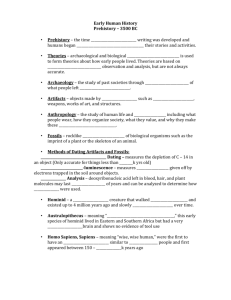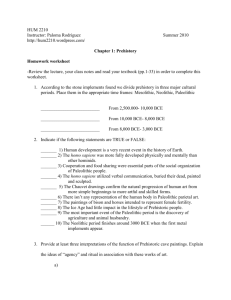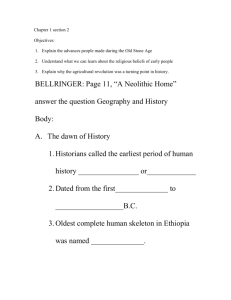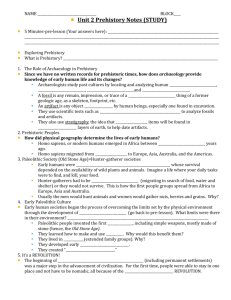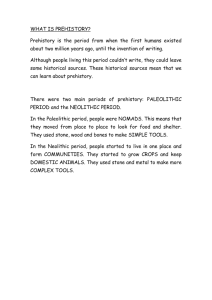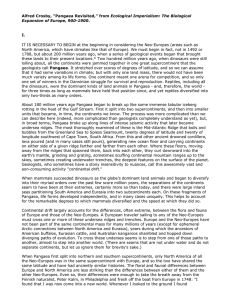Early Human Development
advertisement
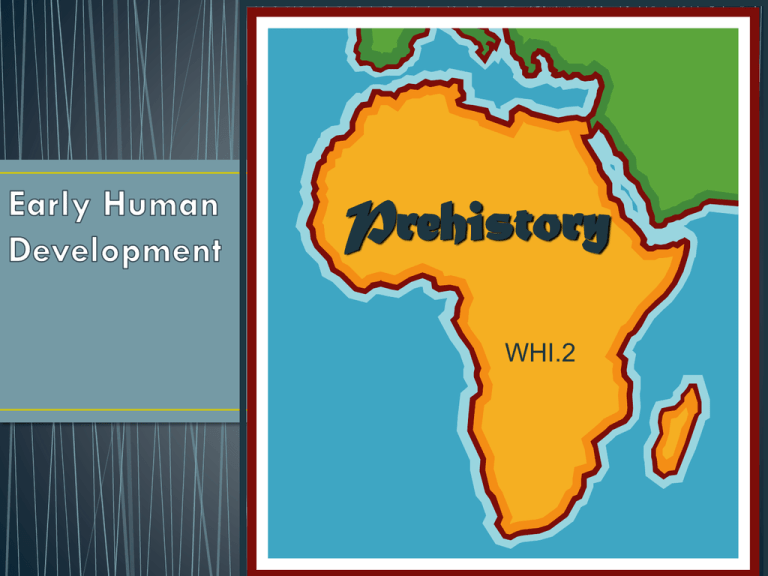
Prehistory WHI.2 Evolution Creation Creationist’s Time Line 6000 YA 4400 (4000 BC) years ago Creation Flood Jesus’ Birth Evolutionist’s Time Line 20,000,000,000 Years Ago Big Bang 2000 • 4,000,000 B.C. (Africa) Early hominids appear • 2,500,000 B.C. Paleolithic Age begins • 1,600,000 B.C. (Africa, Asia, Europe) Homo erectus appears • 200,000 B.C. (Europe, Southwest Asia) Neanderthals appear • 40,000 B.C. (Europe) Cro-Magnons appear • 8000 B.C. Last Ice Age end; Neolithic Age begins • 8000 B.C. (Africa, Asia) Agriculture begins • Life in early hunter-gatherer societies was shaped by their physical environment. • Homo sapiens emerged in east Africa between 100,000 and 400,000 years ago. • Homo sapiens migrated from Africa to •Eurasia, •Australia, •and the Americas. • Early humans were hunters and gatherers whose survival depended on the availability of wild plants and animals. • Early human societies, through the development of culture, began the process of overcoming the limits set by the physical environment. • Hunter-gatherer societies during the Paleolithic Era (Old Stone Age): • were nomadic, migrating in search of food, water, shelter • invented the first tools, including simple weapons • learned how to make and use fire • lived in clans • developed oral (spoken) language • created “cave art.” • The beginning of agriculture, including permanent settlements, was a major step in the advance of civilization. • How did the beginning of agriculture and the domestication of animals promote the rise of settled communities? • Societies during the Neolithic Era (New Stone Age) • developed agriculture (domesticated plants) • domesticated animals • used advanced tools • made pottery • developed weaving skills. • study past cultures by • locating and analyzing human remains, • settlements, fossils, • and artifacts. • apply scientific tests, such as carbon dating, to analyze fossils and artifacts. • Stonehenge is an example of an archaeological site in England that was begun during the Neolithic Age and completed during the Bronze Age. • Aleppo and Jericho are examples of early cities in the Fertile Crescent studied by archaeologists. • Çatalhöyük is an example of a Neolithic settlement currently under excavation in Anatolia. From where does man originate? How many years ago did man begin to move out of Africa to other areas? 1. Domestication 2. Hominid 3. Homo sapiens 4. Carbon-dating 5. Agriculture 6. Prehistory a) Farming b) Name for modern man c) Taming of animals for human use d) Period before written records were kept e) “Human-like” creature f) Test used to determine the age of fossils The objects identified in the picture would most likely come from which period of time? A Paleolithic period B Iron Age C Neolithic period D Bronze Age The typical hunter−gathering societies are best described as — A large cities with unlimited resources B moderate numbers of people living in permanent villages C large numbers of people living in small villages D small nomadic bands of people Which of the following is not a characteristic of the Paleolithic period? F Spoken language G Villages H Hunting −gathering J Small clans A hunter−gatherer society would most likely develop in an area — A near an ocean B with many raw materials C where animals are plentiful D near cities Which of the following statements about the Neolithic period is not true? F It began with the Agricultural Revolution. G During this period, domesticated animals were a part of village life. H It was the longest period of Prehistory. J During this period, man became food producers rather than food gatherers. Which of the following events occurred last? A Development of oral language B Control of fire C Invention of the wheel D Hunting and gathering Any object shaped by human hands is referred to as — F a bone G an artifact H a fossil J a tool

